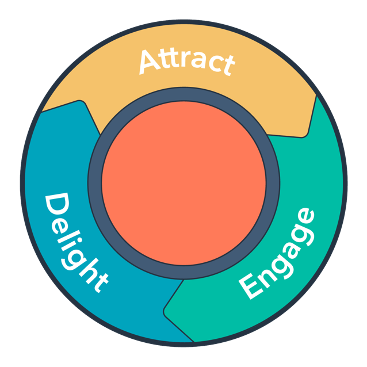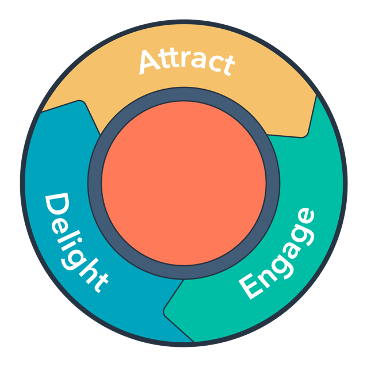Get WISER with Your AI Prompts - A guide for sales managers
Everyone’s wittering on about AI like it’s the second coming. But here’s the rub: if you give it half-baked prompts, you’ll get half-baked answers....
8 min read
 Courtney Sembler
21/07/2020 12:00:00 PM
Courtney Sembler
21/07/2020 12:00:00 PM

This is written by guest blogger Courtney, Manager for HubSpot Academy Education.
Lead nurturing is important in inbound marketing because it’s your opportunity to provide value to your leads and customers and help them grow with your business. As an inbound professional, you might ask yourself, “How do I connect with my prospects and turn them into customers in the most helpful way?”
Lead nurturing is the answer.
Lead nurturing is the process of building relationships with your prospects with the goal of earning their business when they’re ready. In practice, lead nurturing is a marketing effort focused on engaging with your leads and customers in a way that encourages them to progress toward a specific action. It’s a critical piece to building an effective email marketing strategy.
Lead nurturing is the timely, efficient, and targeted approach to connecting with your contacts. And by taking this kind of approach, you can deliver helpful content with the right context. So the big question you need to answer is—what makes lead nurturing so important to your success with inbound marketing?
It’s important to know where your lead nurturing efforts fit into the inbound methodology. How are you going to use lead nurturing to achieve your goals?
When we look at the three stages of the flywheel — attract, engage, and delight — lead nurturing lives primarily in the engage stage.

Successful lead nurturing helps you focus on providing value to your leads by offering them the information they need at the right time.
Each lead you have in your database should be nurtured according to their interests and lifecycle stages. Pages they’ve visited and content they’ve consumed all indicate shifting interests. Good nurturing adapts the messaging to stay relevant and helps you win new customers, faster. Good nurturing helps you keep up the conversation with your contacts. And this helps you continue to connect after they become customers and could be looking for more information from you and your company.
You provide this value to your customers, and they give you value in return, helping you grow your business. This is where you see success with lead nurturing. It’s the best of both worlds – growth for your leads and growth for you.
Lead nurturing is a timely, efficient, and targeted approach to connecting with your contacts. Let’s look into each of these three aspects to understand how to connect with your contacts.
One problem that inbound professionals face is finding the right time to connect with leads when they’re most interested. And one problem your leads face is being contacted at the wrong time. This is where lead nurturing comes in.
Lead nurturing is delivered through marketing automation. When we say marketing automation, we’re referring to the software that exists with the goal of automating your marketing actions. Many marketing professionals have to automate repetitive tasks, such as emails, social media, and other website actions, or they want to build systems of automated workflows that help them streamline and manage their campaigns. Marketing automation technology makes these tasks easier and helps you deliver your content to your leads at the right time.
With marketing automation, you can develop nurturing campaigns that deliver the right content based on the actions your leads take with your company. Using your marketing automation software, you can trigger events to happen after your contacts have taken certain actions, such as downloading a piece of content, opening a specific page, or requesting information from you.
For example, if a contact downloads a piece of content on “The Best Ways to Create Subject Lines for Email Newsletters,” you’ll then be able to send a follow-up piece of content that builds off that subject. This could be a blog post on how to write effective email copy. You’re continuing the conversation with additional content that has context in what they’re interested in learning about.
With marketing automation software in your inbound toolbox, you can take full advantage of the benefits of timeliness and help your leads get their answers faster.
Marketing automation software doesn't just help you be timely but helps you to automate in general.
HubSpot found that the odds of an inbound lead becoming qualified are 21 times greater when they’re contacted within 5 minutes vs 30 minutes. This type of speed is possible through automating tasks and reducing the time a salesperson has to spend on qualifying or warming up a lead. It’s all about efficiency. The content and interactions a lead will experience through your lead nurturing campaign will do the heavy lifting to leave you and your teams to focus on creating helpful content, connecting with leads through sales faster, and reviewing data to continue optimising your efforts — in other words, being human, helpful, and holistic.
Your marketing automation doesn’t do marketing and lead generation for you, but it can scale your efforts and increase the value you provide to your contacts in a more efficient way.
Timeliness and efficiency together bring us to the third aspect of lead nurturing: Targeting your leads in the right way.
By using lead nurturing, you can tie a series of emails to a specific activity or conversion event. In other words, you can craft your emails based on the action your lead or customer takes. This shows them you’re aware of their interests and providing them with what they might need next. When connecting with your contacts, you want to be as human as possible. Being human is what builds trust, and trust is what helps you become successful as a business. Your lead nurturing campaigns provide contextual messages to your contacts, which is key to building that trust — it’s about being targeted and more engaging to your lead or customer.
These are the three most important aspects of lead nurturing and why it’s crucial to your success with inbound marketing — it’s a timely, efficient, and targeted approach to connecting with your contacts. Inbound professionals use lead nurturing to help their contacts grow with their business. You can nurture your leads by engaging with them on an ongoing basis and gradually guiding them through the buyer's journey with both helpful content and context.
Lead nurturing campaigns can be the foundation of any type of communication between your business and the people who are interested in buying something from you.
But remember, marketing automation isn’t a “set it and forget it” shortcut to more revenue. It’s an opportunity to scale the way you communicate with your potential customers, as long as you send emails that add value, not ask for it.
Five steps to managing a lead nurturing campaign:
Follow these steps to build an effective lead nurturing campaign to have helpful conversations with your leads and customers.
Lead nurturing is all about focusing your efforts on providing value at every stage for your contacts. Think about how you develop relationships in other aspects of your lives. You don’t present all the information up front and hope the other person likes you. You have conversations and get to know them through communication that develops naturally.
It should be the same with these relationships. You need to have conversations of value throughout a prospect’s lifecycle and then continue that conversation through their customer lifecycle as well.
By moving through the five main steps of creating a lead nurturing campaign, you are going to create a series of content that will help your leads reach a goal or action.
Inside your campaigns, you will have different types of emails that help you deliver this information.
These emails create relevancy and value that will condition your contacts to trust and therefore open future emails from you.
For example, an email that educates your audience on a topic that they have shown interest in to begin with.
These emails educate your leads and give you valuable insight into which topics and information resonate with them.
This could be emails that both provide the download but also educate them further on the topic in the email.
This email type positions the goal of your campaign as the next logical step for a contact to take. They are direct and to the point.
While all emails have call-to-actions this type of email will be specific to the goal of your workflow. For example, getting them to schedule a demo or chat with sales.
These emails make it clear this is the last time a lead will hear from you. The goal is to keep these contacts engaged or to learn why you missed the mark with your messaging
These email types have something in common as well. They each have a goal tied directly to the reason you’re sending them.
Having goals is a best practice for sending great email, and it’s just as important in your lead nurturing campaigns.
By adding these four email types to the five steps of creating a lead nurturing campaign, you’re ready for our next question: How do you now deliver this information in your campaigns?
This is where behavioural email comes into your lead nurturing strategy and campaigns.
Behavioural email can be defined as the practice of sending automated, targeted emails to your contacts based on the historical interactions they've had with your company across channels.
Behavioural email is all about adopting a user-focused approach to sending email. It is the actions your leads take that dictate which emails they receive, not a decision made by a marketer.
According to a MarketingSherpa study, 39% of marketers said that “automatically sending emails based on triggers” is the most effective tactic for improving email engagement.
Behavioural email becomes the fuel that powers your email engagement.
A core piece of your inbound marketing, sales, and service strategies is having a database that centrally stores and tracks information on your contacts and their behaviours (aka a CRM).
Each channel you use is a chance to listen to your contacts, learn more about them, and start a conversation based on the information you gather.
If you’re going to do email marketing, lead nurturing, and behavioural email with any effectiveness, it’s important that your emails are tapping into some sort of database that tracks this information. This information is valuable to your business, but it’s also valuable for your contacts — the more you know what they want, the easier it is to provide them with only the information that’s valuable to them.
This is the first step in sending behavioural email because you need to know what types of interactions your contacts are having with you.
Behavioural emails are so effective because they are triggered based on the contact’s actions.
Behavioural email is built upon the idea that every action a contact takes has an expected and purposeful reaction. Using the information in your contact database, you have what you need to offer the right reactions.
For example, let’s say a lead views a specific page on your website, say, your case study page. You then send targeted follow-up content like one of your more popular case studies. Or let’s say a lead hasn’t visited your blog in the last 90 days. So you send them an email saying you miss them and add links to some of your recent blog posts that are relevant to where they are in their buying journey.
These are all based on the contact’s behaviour, and as you follow-up, you are nurturing them toward the action you wish them to take but providing value along the way.
When you send a behavioural email, you are creating a highly personal experience. Think about the foundations of lead nurturing: It’s a timely, efficient, and targeted approach to connecting with your contacts.
You know your contacts are not interacting with your nurturing campaigns in a bubble. You can now tap into your contact database and send emails that are highly personalised. Use personalisation to design a truly unique experience for each person who interacts with you and your business.
Tracking how contacts interact with you, determining the important actions a contact might take, and lastly, starting a conversation with your contacts based on those behaviours will help your nurturing campaigns be a highly personal and engaging experience for your users. This will help you and your business grow alongside them.
When you think about your overall lead nurturing strategy, keep this rule in mind — treat people the way you want to be treated.
Treat your contacts the way you want to be treated and show them value. With this mindset, you will be able to continually develop relationships with your leads as they move through their buying journey and well into their customer lifecycle with you.
More about the author
 Courtney hails from San Francisco, CA and moved to Boston, MA to work for HubSpot in 2015. She currently works as the Manager for HubSpot Academy Education dedicated to leading the inspiring and passionate Inbound Professors. She was a previous Inbound Professor focused on email marketing, GDPR, and contact management. She is devoted to education, environmental programs, and a true email geek.
Courtney hails from San Francisco, CA and moved to Boston, MA to work for HubSpot in 2015. She currently works as the Manager for HubSpot Academy Education dedicated to leading the inspiring and passionate Inbound Professors. She was a previous Inbound Professor focused on email marketing, GDPR, and contact management. She is devoted to education, environmental programs, and a true email geek.
Subscribe to our latest news and updates on HubSpot.

Everyone’s wittering on about AI like it’s the second coming. But here’s the rub: if you give it half-baked prompts, you’ll get half-baked answers....

The business world is falling head over heels for AI—and who can blame it? With promises to reduce grunt work, uncover insights, and turbocharge...

Search is evolving - fast. For two decades, SEO has revolved around Google’s algorithm: keywords, backlinks, metadata, and page speed. But with the...